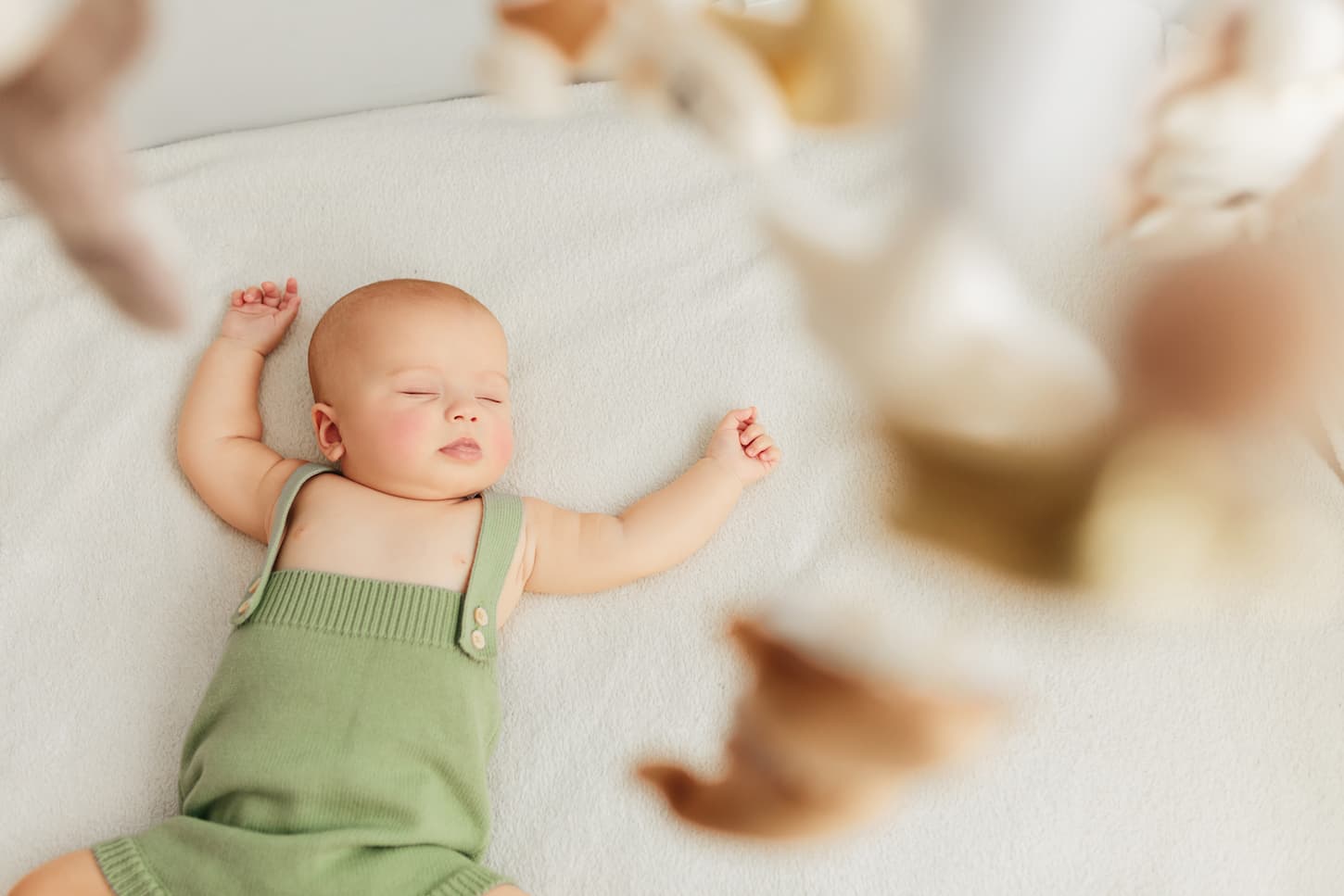When your baby catches their first cold, they really don’t want to sleep laying down – they want to be held or at least propped up to sleep. But can you prop your baby up to sleep safely – when ill or when sleep training? Is it safe? How should you do it?
Babies should sleep on their backs. Babies with reflux or mild illness may breathe and sleep better if propped up on a slight incline, no more than 10 degrees. The incline should be stable and stationary, ideally under the fitted sheet, mattress, or crib itself. If in doubt, ask your pediatrician.
Now, if you’re ever unsure about using an incline, I always recommend that you talk to your child’s pediatrician. They’ll be able to give you the best, most specific-to-your-child information about inclined or propped-up sleeping possible. But if you just want the basics and generalized information? Then be sure to keep reading – I’ll share everything I’ve learned as a pediatric nurse and mom to four kiddos!

When and Why Would I Need to Prop Up My Baby to Sleep?
There are two main times when you would want to prop your baby up to sleep. Both are times when your pediatrician can prescribe or recommend exactly what to do. So please be sure to talk to them about it. They can also give you the other times when it’s okay to prop up your baby to sleep.
Even so, here’s the info on those two most common times when it’s good to prop your baby up to sleep.
- Reflux – Many babies suffer from something called reflux, also known as acid reflux or GERD (gastroesophageal reflux disease). Reflux is a very common complaint as babies’ digestive systems are still getting used to the whole digesting thing. Right after eating, their stomach can’t process all of the milk, so it comes back up. For many babies, it will go away all by itself without much other than positioning management. Other babies may need medication.
- Minor illnesses – Many babies, when they’ve got a minor illness like a cold, get so congested that they have a difficult time breathing. Propping a baby up in addition to using a good suctioning technique and a humidifier can help your baby sleep so much better – and help them heal that much faster.
You’ve probably noticed that when you’ve got an upset stomach or a cold that how you lay down affects your quality of sleep. It’s the same kind of thing for babies.
Should I Prop My Baby Up to Sleep When Sleep Training?
If your baby doesn’t need to be propped up regularly for reflux treatment, then you shouldn’t need to prop them up to sleep when sleep training.
Babies that have reflux and need to be propped up to sleep will just have their sleeping arrangements permanently in the propped-up position.
Please remember that not every baby with acid reflux needs to sleep propped up. For many babies with more minor reflux, being held upright-ish for 15-20 minutes after eating is usually sufficient to manage the reflux. And if you’re following the “eat, play, sleep” or baby wake window cycles, then your baby can sleep on their back just fine. No need to prop them up at all – or for sleep training.
And if your baby needs to be propped up to sleep for a mild cold? Then now isn’t the time to be sleep training. Help your baby get better first – and then get back to sleep training.
How to Safely Prop Up Your Baby to Sleep (Any Time)
There are several easy ways to adjust your baby’s sleeping position so that they are more comfortable. Rather than spend hundreds of dollars on the latest gadget, why not start with something you’ll have laying around the house?
Simply take a rolled-up towel or a (very low) pillow and place it under the mattress to slightly raise where your baby’s head will be. It’s important not to make too steep an incline, as this can cause problems with a baby’s airway.
Babies cannot use pillows nor wedges as pillows, as they can angle a baby’s neck in such a way as to occlude their airway.
Babies’ airways need to be flat. The only way to do that is by having them flat on their back. A pillow under a baby’s head can make them struggle to breathe (or suffocate) by bending their airway too much. So use the mattress to keep your baby flat – and only elevate one end of the mattress a little bit to get the “propped up” effect.
Furthermore, putting anything in your baby’s crib other than your baby and the fitted sheet under them (that’s securely attached to the mattress) is not considered completely safe.
However, If you’re baby’s reflux or blocked nose is causing them (and you) many a sleepless night, then another way to prop them up is to place a wedge UNDER the mattress, to put the whole sleeping surface on an incline, rather than putting a wedge pillow in the crib with the baby.
Here are some things to consider:
- Make sure that the wedge you use is breathable.
- Please keep it clean.
- A gradual incline is safer than a steeper wedge at the baby’s head (to ensure the airway is kept clear).
- All products are better used under supervision, especially with a newborn. So make sure you’re in the room or nearby.
Another option is one used by nurses in the hospital. However, this method is probably best when your baby is bigger, has a stronger neck, is able to turn their head to the side if they need to, and your baby has appropriate levels of supervision. Prop your baby up on one side with a rolled-up towel behind them to support. This should be more comfortable for them than laying on their back if they are suffering from reflux or a blocked nose.
Can I Prop My Newborn Up to Sleep?
Newborn babies can also be propped up to sleep if it’s recommended by their pediatrician. Newborn babies are at a higher risk of SIDS before 6 months of age (90% of SIDS cases happen in this time frame). So if you are going to prop them up, please do what you can to keep them on their back, as recommended by the American Academy of Pediatrics.
Again, the two most common reasons to prop up a baby (or a newborn) to sleep are:
- Due to reflux (GERD).
- Because of a minor illness like a stuffed nose.
If you decide to prop up your newborn, because of reflux or a blocked nose, then you should make sure you’re with your baby, and that, again, you only put things under the mattress, not in the crib with the newborn baby. A small towel, rolled up, could give the slight incline you need. Or you could get one of the smaller, newborn-specific pillows on the market.
How Do I Keep My Baby Upright to Sleep?
Newborns don’t need to be kept completely upright to sleep unless directed to by a pediatrician. Newborns generally need to sleep on their backs. The “back is best” campaign is designed to help offset the risk of SIDS in babies.
If you need to prop up your baby to sleep on a slight incline, then please refer to the earlier section of this article on how to prop up a baby to sleep at any time.
Best Products to Prop Baby Up to Sleep
There are many products on the market that promise the world when it comes to helping babies sleep. When you’re rocking a screaming baby, it’s easy to jump on Amazon and scroll for a product that promises a quick fix. In fact, if you’re anything like me and millions of other parents, then you’re more susceptible to outlandish claims from companies who want your money.
Part of the reason that I started this website was to help offset the pain of feeling like I needed to try “all the things” to help my children sleep. So please don’t rush out to buy any new products.
The safest way for a baby to sleep is on its back, on a flat, firm mattress. Keep the crib (and mattress) clear of any items (such as a blanket, pillows, soft toys, bumpers, etc.) in a cool, ventilated room.
If you insist on having a wedge to support your baby, please know that current legislation on baby products is evolving (source).
I used to list a few options on this site, but due to recent changes, I have removed all of my former recommendations. When there is more data supporting something, I’ll add it back in here.
And, as a personal note, I never used wedges – I just used a rolled-up towel under the mattress. It’s what I was used to from working as a nurse in the hospital, so it’s what I naturally went to.
More Info on Propping Baby Up to Sleep and Related Topics
There are some other things that you can do to help with your baby’s comfort while they’re sleeping.
- Practice tummy time during the day. This helps your baby to build the neck and arm strength to adjust themselves at night.
- Use an air humidifier, or a diffuser with menthol essential oils in it can help clear your baby’s nose if they’re all blocked up.
- Keep your baby at least a 45-degree angle for 20 to 30 minutes after a feed, to make sure that they have enough time to digest their milk can reduce reflux symptoms.
- Follow the Eat-Play-Sleep cycle. Once you’ve begun sleep training, consider moving the last feed of the day earlier in your bedtime routine. A baby with reflux will find it harder to self-settle soon after a feed as they will be more uncomfortable.
We know just how hard it is to function when you’re sleep-deprived, and we know how heartbreaking it can be to see your baby in discomfort and be unable to do anything about it. Now that you’re armed with the information you need, we’re sure you will be on your way to some more restful nights.

Related Questions
How Can I Prop My Baby Up to Sleep When Sleep Training? Propping up a baby to sleep while sleep training can be done in the exact same way as in general (when not sleep training). Prop up your baby using an under-mattress wedge or rolled-up towel. Please refer to the earlier section in this article for more ideas.
Is Propping Baby Up to Sleep When Sleep Training Safe? Propping up your baby to sleep when sleep training can be done safely, yes. But most babies don’t need it. So only prop them up to sleep during sleep training if they need it.
Can Newborns Sleep on an Incline? Newborns can sleep on a slight incline as long as they are still on their back. Please refer back to the section of this article on newborns for more information.